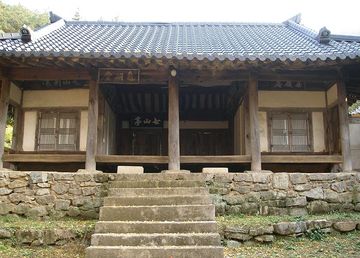"밀양 칠산정"의 두 판 사이의 차이
(→영문 해설 내용) |
(→영문) |
||
| 33번째 줄: | 33번째 줄: | ||
===영문=== | ===영문=== | ||
| + | '''Chilsanjeong Ritual House, Miryang''' | ||
| + | Chilsangeong Ritual House was built in 1906 for the preparation of ancestral rituals and the maintenance of the tomb of the Confucian scholar Son Eung-nyong (1741-1822, pen name: Chilsanong). Originally, a ritual house was built here in 1863 by Son’s descendant Son Geon but was destroyed by a fire in 1895. The current building was constructed by Son Geon’s grandson Son Gi-hyeong to serve as his private villa and a ritual house. At the time of completion of the original building in 1863, it was given the name Moseonjae, meaning “the Ritual House of Remembering the Ancestor,” which during the reconstruction was changed to Chilsanjeong after Son Eung-nyong’s pen name. Son is known to have been a devoted teacher who raised many students and a generous man who provided help to the poor families in the area. | ||
| − | + | The ritual house consists of a spacious wooden-floored hall and an underfloor-heated room on each side. The hall was used for gatherings, and the rooms were reserved for those performing the rituals. The scale and the layout of the current building largely correspond to the records describing the original ritual house, which suggests that the ritual house was rebuilt according to its original plan. To the right of the ritual house is Cheongsongnu Pavilion which was used as a ritual preparation hall. It consists of an underfloor-heated room and an elevated wooden porch. Such porches were a popular choice when building a house on an inclined terrain in the Miryang in the 20th century. | |
===영문 해설 내용=== | ===영문 해설 내용=== | ||
2023년 1월 18일 (수) 07:20 판
| 밀양 칠산정 |
|
 밀양 칠산정, 국가문화유산포털, 문화재청. |
|
| 대표명칭 | 밀양 칠산정 |
|---|---|
| 한자 | 密陽 七山亭 |
| 주소 | 경상남도 밀양시 단장면 구미3길 48-38 |
| 지정번호 | 경상남도 문화재자료 제478호 |
| 지정일 | 2009년 10월 22일 |
| 분류 | 유적건조물 |
| 수량/면적 | 4동 |
| 웹사이트 | 밀양 칠산정, 국가문화유산포털, 문화재청. |
해설문
국문
조선 후기 유학자 손응룡(1741~1822)의 묘제(墓祭)*를 모시기 위해 증손자 건(鍵)이 1863년 묘소 아래에 지은 재숙소(齋宿所)가 화재로 소실되자 손자 기형(基亨)이 1906년 별장을 겸해 새로 지었다. 조선 말기에서 근대 초기에 이르는 격동기에 벼슬길에 나아가지 않은 밀양 향반(鄕班)들의 재실 건축 경향과 특징을 보여준다.
창건 당시 당호는 모선재(慕先齋), 구호당(龜湖堂)이었으나 중창하면서 칠산정이라고 고쳐 불렀다. 칠산은 손응룡의 호 칠산옹(七山翁)에서 따왔다. 그가 후진을 양성하고 빈곤한 가정에 도움을 줬다는 행적은 모선정기(慕先亭記), 칠산정 12경(七山亭 12景) 등의 현판에 기록되어 있다. 가운데 마루는 모임 장소로, 좌우 온돌방은 제관들의 거처로 사용됐다. 칠산정 서편에 들어선 청송루(廳松樓)는 온돌방과 누마루를 겸비한 누각이다.
건물 규모와 배치가 모선정기 내용과 상당 부분 부합해 창건 당시 모습에 준해 중창되었음을 알 수 있다. 자연적인 경사를 살려 건물 끝에 누마루를 조성하는 기법은 이 시기 밀양 지방 누정(樓亭)에 나타나는 특징이다.
- 묘제: 무덤 앞에서 지내는 제사.
영문
Chilsanjeong Ritual House, Miryang
Chilsangeong Ritual House was built in 1906 for the preparation of ancestral rituals and the maintenance of the tomb of the Confucian scholar Son Eung-nyong (1741-1822, pen name: Chilsanong). Originally, a ritual house was built here in 1863 by Son’s descendant Son Geon but was destroyed by a fire in 1895. The current building was constructed by Son Geon’s grandson Son Gi-hyeong to serve as his private villa and a ritual house. At the time of completion of the original building in 1863, it was given the name Moseonjae, meaning “the Ritual House of Remembering the Ancestor,” which during the reconstruction was changed to Chilsanjeong after Son Eung-nyong’s pen name. Son is known to have been a devoted teacher who raised many students and a generous man who provided help to the poor families in the area.
The ritual house consists of a spacious wooden-floored hall and an underfloor-heated room on each side. The hall was used for gatherings, and the rooms were reserved for those performing the rituals. The scale and the layout of the current building largely correspond to the records describing the original ritual house, which suggests that the ritual house was rebuilt according to its original plan. To the right of the ritual house is Cheongsongnu Pavilion which was used as a ritual preparation hall. It consists of an underfloor-heated room and an elevated wooden porch. Such porches were a popular choice when building a house on an inclined terrain in the Miryang in the 20th century.
영문 해설 내용
칠산정은 조선시대의 유학자 손응룡(1741-1822, 호: 칠산옹)의 묘소를 수호하고 제사를 모시기 위해 1906년에 지은 재실이다. 원래 이곳에는 1863년 증손자 손건이 지은 재실이 있었는데 1895년 화재로 소실되었고, 1906년 손건의 손자 손기형이 별장을 겸해 지금의 재실을 새로 지었다. 창건 당시에는 “선조를 추모하는 재실”이라는 뜻의 모선재(慕先齋)라 하였으나, 새로 지으면서 손응룡의 호를 따라 칠산정이라고 고쳐 불렀다. 손응룡은 밀양 지역에서 후진을 양성하고 빈곤한 가정에 도움을 준 것으로 알려져 있다.
칠산정은 가운데 넓은 마루가 있고 양옆에 온돌방이 있으며, 마루는 모임 장소로, 온돌방은 제관들의 거처로 사용됐다. 창건 당시의 기록과 비교해볼 때 건물 규모와 배치가 상당 부분 부합하므로, 새로 지을 때 창건 당시의 모습에 따라 지었음을 알 수 있다.
칠산정 오른쪽에는 전사청으로 지어진 청송루가 있다. 온돌방과 누마루로 이루어져 있으며, 자연적인 경사를 살려 건물 끝에 누마루를 조성하는 기법은 20세기 밀양 지방 누정에 나타나는 특징이다.